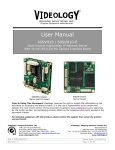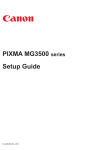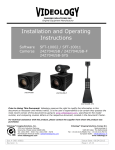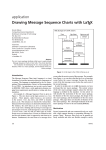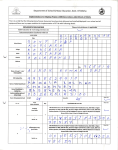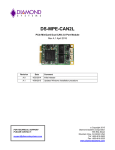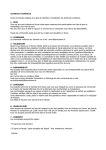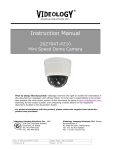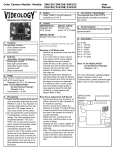Download User manual - Videology Imaging Solutions, Inc.
Transcript
User Manual 60SVM1 / 60SVM1-E Dual Channel Audio/Video IP Network Server With 8-bit (BT656 or BT601) HD Camera Interface Board 60SVM1 shown Server and I/O board 60SVM shown Server board Prior to Using This Document: Videology reserves the right to modify the information in this document as necessary and without notice. It is the user’s responsibility to be certain they possess the most recent version of this document by going to www.videologyinc.com, searching for the model number, and comparing revision letters on the respective document, located in the document’s footer. For technical assistance with this product, please contact the supplier from whom the product was purchased. Videology® Imaging Solutions, Inc. 37M Lark Industrial Parkway Greenville, Rhode Island 02828 USA Tel: (401) 949 – 5332 Fax: (401) 949 – 5276 North/South American Sales: [email protected] www.videologyinc.com Doc # INS-60SVM1 Revision: B Videology® Imaging Solutions, Europe B.V. Neutronenlaan 4 5405 NH Uden, The Netherlands Tel: +31 (0) 413 256261 Fax: +31 (0) 413 251712 European Sales: [email protected] www.videology.nl Issue Date: 01/16/2014 Page 1 of 28 Table of Contents 1. 2. 3. Introduction................................................................................................................ 4 Document History ....................................................................................................... 4 Hardware .................................................................................................................... 5 3.1. Block Diagram ....................................................................................................... 5 4. Inputs/Output ............................................................................................................ 6 4.1. Video Inputs .......................................................................................................... 6 4.2. Video Output ......................................................................................................... 6 4.3. Audio Input ........................................................................................................... 6 4.4. Audio Output ......................................................................................................... 6 4.5. GPIO Lines ............................................................................................................ 6 4.6. RS-232 ................................................................................................................. 6 4.7. I2C ....................................................................................................................... 6 4.8. SD Card Interface ................................................................................................... 6 4.9. Network Interface................................................................................................... 6 4.10. Programming Interface ........................................................................................... 6 4.11. Power Supply ......................................................................................................... 6 5. A/V Encoder Performance ........................................................................................... 7 5.1. Video Codec Capabilities: ........................................................................................ 7 5.2. Audio Encoder Capabilities ....................................................................................... 7 6. Mechanical .................................................................................................................. 8 6.1. Dimensions ............................................................................................................ 8 7. Top Side Connectors (Rev 7 I/O Board) ...................................................................... 9 7.1. J400 10 Pin Header................................................................................................. 9 7.2. J401 3 Pin Header ................................................................................................ 10 7.3. J402 10 Pin Header............................................................................................... 10 7.4. J404 5 Pin Header ................................................................................................ 10 7.5. J405 5 Pin Header ................................................................................................ 10 7.6. J406 20 Pin Header............................................................................................... 11 7.7. J407 2 Pin Header ................................................................................................ 11 7.8. J408 4 Pin Header ................................................................................................ 11 7.9. J409 2 Pin Header ................................................................................................ 12 7.10. J410 3 Pin Header ................................................................................................ 12 7.11. J412 5 Pin Header ................................................................................................ 12 7.12. J600 5 Pin Header ................................................................................................ 12 8. 60SVM1 I/O Board Cable Diagram ............................................................................ 13 9. Web-Based Graphical User Interface ........................................................................ 14 10. System Prerequisites and Setup ............................................................................... 14 10.1. Video Viewer ........................................................................................................ 14 10.2. SMTP and FTP Servers .......................................................................................... 14 10.3. Accessing the DVR Remotely .................................................................................. 15 10.4. Structure ............................................................................................................. 15 10.5. Home Page .......................................................................................................... 15 10.6. Video Page .......................................................................................................... 16 10.6.1. Codec Settings ............................................................................................ 17 10.6.2. Image and Audio Settings ............................................................................. 17 10.7. Alarm Page .......................................................................................................... 17 10.8. Recording Page .................................................................................................... 18 10.8.1. Recorder Settings ........................................................................................ 18 10.8.2. SD Card Settings ......................................................................................... 19 10.9. Playback Page ...................................................................................................... 20 10.10. Network Page ...................................................................................................... 21 10.11. Server Page ......................................................................................................... 22 10.12. System Page ........................................................................................................ 23 10.12.1. System Settings .......................................................................................... 24 10.12.2. User Settings .............................................................................................. 25 Doc # INS-60SVM1 Issue Date: 01/16/2014 Revision: B Page 2 of 28 10.12.3. Configuration .............................................................................................. 26 10.12.4. Firmware Update ......................................................................................... 27 11. Contact Information.................................................................................................. 28 Doc # INS-60SVM1 Revision: B Issue Date: 01/16/2014 Page 3 of 28 1. Introduction The 60SVM1 is a single channel, audio/video, H.264/MJPEG encoder designed around the Maxim MG3500 codec. The 60SVM1-E is the engineering development version of the 60SVM1, and also includes analog video out and debug ports. The encoder is a compact design consisting of a CPU board and interface board sandwiched together. The interface board provides all the necessary connectors to support the numerous video and audio inputs/outputs together with communications and GPIO lines. The main features and capabilities of the 60SVM1 server board include: • • • • • • • • • 2. High definition (H.264/MJPEG) dual streaming video up to 60fps Ultra small 42mm x 42mm server board set Video motion detection Line in audio can be synchronized to video 32GB of SD recording (no frame loss) with overwrite option 10 second pre-alarm buffer 4 GPIOs GPS, LCD and other peripheral device interfaces (engineering evaluation boards available 60SVM1-E) SDK will be PSIA compatible Document History Revision A B Issue Date 01/05/2012 12/05/2013 Doc # INS-60SVM1 Revision: B Author R.M., A.V. RH Reason Initial release of 60SVM1 Updated for dual channel specs CN# 13-0029 13-0081 Issue Date: 01/16/2014 Page 4 of 28 3. Hardware 3.1. Block Diagram The block diagram of the audio video encoder is shown in Figure 1. Power Out to Camera 5 VDC Power Supply +5V +3 +1.8 +1.0 10/100 Ethernet + POE Ethernet MAC Ethernet PHY Analog Video Video A/D I2C Digital Video in CVBS Out Audio in Audio Out 8 / 16 Bit DIG Video H/V Sync. PCLK Video D/A 8 Bit DIG Video H/V Sync. PCLK Audio A/D I2S I2C 16 Bit DIG Video H/V Sync. PCLK H.264 Codec 16 Bit DIG Video H/V Sync. PCLK AAC Audio Codec I2S I2C I2C RTC MICRO Reset DeBUG UART Comms UART RS232 GPIO UART2 GPIO 4 Lines SD Card UART 1 RS232 ARM 926 Processor SD BUS SD Port USB USB USB INTERFACE BOARD CPU BOARD Figure 1: Block Diagram of Audio Video Encoder Doc # INS-60SVM1 Revision: B Issue Date: 01/16/2014 Page 5 of 28 4. Inputs/Output 4.1. Video Inputs The encoder has two video inputs, one analog and one digital. The analog input can accept either CVBS or YC. The digital video input can accept BT.656 or BT.601 8-bit. Each video input can only be used independently. For maximum resolution and frame rates, refer to section 5. 4.2. Video Output There is a single video output, providing standard composite video. FUTURE - The video output can be used for the purpose of camera alignment during installation, or for connection to a local composite video monitor (60SVM1-E only). 4.3. Audio Input The encoder has a single line level (1 V pp) audio input. 4.4. Audio Output FUTURE - The encoder has a single channel audio output. 4.5. GPIO Lines The encoder has 4 TTL level GPIO lines. These lines may be used for alarm inputs (outputs are in development). 4.6. RS-232 The encoder includes two RS-232 ports, one for debug and one as a general purpose UART (60SVM1-E only). 4.7. I2C The encoder provides an I2C output for direct control of camera functions such as shutter speed, white balance, etc (60SVM1-E only). 4.8. SD Card Interface The encoder includes a single SD card interface, for storage of video and or audio onto a local SD card. The board will support Class 6 or Class 10 SD cards with a capacity up to 32GB (64GB in progress). Refer to GUI software manual for detailed information on recording features. 4.9. Network Interface 10/100 BaseT Ethernet 4.10. Programming Interface There is an on-board microcontroller which is used for system initialization. This connector is not intended for customer use. 4.11. Power Supply The board is powered by 5 V DC with a total power consumption of 2.1 W. Doc # INS-60SVM1 Revision: B Issue Date: 01/16/2014 Page 6 of 28 5. A/V Encoder Performance 5.1. Video Codec Capabilities: • • • • • • Supports H.264 base, main and high profiles. Supports MJPEG encoding/decoding. Variable or constant bit rate. Encoding or decoding up to 1080i at 30 FPS or 1080p at 15 FPS. Programmable resolutions and frame rates. Video bit rates: 64 kB/s – 62.5 MB/s. The encoder can support multiple resolutions and frame rate combinations (depending of course on the video sensor being used). The following table lists some of the standard formats supported. The listed resolutions are for NTSC standard, although both NTSC and PAL are supported. Format 1080p 1080i 720p D1 VGA CIF SCIF QCIF 1.3M • • • • Resolution H and V 1920 x 1080 1920 x 1080 1280 x 720 720x 486 640 x 480 352 x 288 320 x 240 176 x 144 1280 x 1024 Max Frame Rate 15 30 45 60 60 60 60 60 15 Scan Format Progressive Interlaced Progressive Interlaced / Progressive Interlaced / Progressive Interlaced Interlaced Interlaced Progressive Note that for 1080i, the image consists of two interlaced fields and thus produces a full frame every 1/30 second. 1.3M format is specific to Videology’s 1.3 MP digital camera (24C1.3X-DIG). Multiple simultaneous streams can be supported, the exact combinations available will depend upon resolution and frame rate, bit rate etc. But as a rough guide, four simultaneous D1 streams at 30 FPS can be supported. By utilizing the scaling feature within the video pre-processor, any picture size and aspect ratio can be created. 5.2. Audio Encoder Capabilities • • • • Single channel I2S audio input. Output (60SVM1-E only). High-fidelity, 2-channel AAC-LC codec (Default). G.711 codec. Flexible bit rates and sample rates. Doc # INS-60SVM1 Revision: B Issue Date: 01/16/2014 Page 7 of 28 6. Mechanical 6.1. Dimensions Doc # INS-60SVM1 Revision: B Issue Date: 01/16/2014 Page 8 of 28 7. Top Side Connectors (Rev 7 I/O Board) Top Side 7.1. J400 10 Pin Header MOLEX 53398-10 Ethernet Connection Pin # 1 2 3 4 5 6 7 8 9 10 Doc # INS-60SVM1 Revision: B Function Digital Ground Transmit + Transmit Receive + Receive Center Tap No Connection Phy Power LED Link Indicator LED Speed Indicator Label Digital GND TX + TX RX + RX CT NC 3.3V DC LED LINK LED LINK Issue Date: 01/16/2014 Page 9 of 28 7.2. J401 3 Pin Header JST-BM03B-SRSS-TB Audio Pin # 1 2 3 Function Audio Line In Analog Ground Audio Line Out 7.3. J402 Label DS_LIN_CH1 GND DS_LOUT_CH1 10 Pin Header Type Molex-53398-10 SD Card Interface Pin # 10 9 8 7 6 5 4 3 2 1 Function SD Card Data 2 SD Card Data 3 Command 3.3V Power GROUND SD Card Clock SD Card Data 0 SD Card Data 1 SD Card Detect Write Protect 7.4. J404 Label SD D2 SD D3 SD CMD 3.3V GND SD CLK SD D0 SD D1 SDCD SD WP 5 Pin Header JST-BM05B_SRSS-TB Debug UART Pin # 1 2 3 4 5 Function Port 1 Receive Data Port 1 Receive Data GROUND Port 2 Receive Data Port 2 Receive Data 7.5. J405 Input Output Input Output Label MG_RX_DBG MG_TX_DBG DGND DS_RX_DBG DS_TX_DBG 5 Pin Header JST type JST-BM05B-SRSS-TB SPI Ports Pin # 1 2 3 4 5 Doc # INS-60SVM1 Revision: B Function SPI Data Out SPI Port Clock SPI Port Chip Select SPI Port Data Out Digital Ground Label MISO MCLK SSI MOSI DIG GND Issue Date: 01/16/2014 Page 10 of 28 7.6. J406 20 Pin Header JST –BM20B-SRDS-G-TF Digital Camera In/Out Pin # 1 2 3 4 5 6 7 8 9 10 11 12 13 14 15 16 17 18 19 20 Function Ground Ground Pix CLK V Sync H Sync Ground Ground D0 D1 D2 D3 D4 D5 D6 D7 Ground Ground Sensor Reset Iris Out 5V 7.7. J407 Label GND GND MG VID1 PIX CLK MG VID1 V SYNC MG VID1 H SYNC GND GND MG VID0 D8 MG VID0 D9 MG VID0 D10 MG VID0 D11 MG VID0 D12 MG VID0 D13 MG VID0 D14 MG VID0 D15 GND GND Sensor_RST_N Iris +5 V 2 Pin Header JST type CON-JST-BM02B-SRSS-TB Power In Pin # 1 2 Function +5 V In Ground 7.8. J408 Label +5 V GND 4 Pin Header JST-BM04B_SRSS-TB Video In Pin # 1 2 3 4 Function Video C In Video Y In* Ground +5V Label DS-VIDC-IN DS-VIDY-IN GND +5V *The Y input is used for CVBS input, with appropriate software changes. Doc # INS-60SVM1 Revision: B Issue Date: 01/16/2014 Page 11 of 28 7.9. J409 2 Pin Header JST type CON-JST-BM02B-SRSS-TB Video Out Pin # 1 2 Function CVBS_OUT Ground 7.10. J410 Label DS_CVBS_OUT GND 3 Pin Header JST-BM03B-SRSS-TB I2C Pin # 1 2 3 Function I2C Data I2C Clock I2C Ground 7.11. J412 Label TW_SDAT TW_SCLK DGROUND 5 Pin Header JST-BM05B_SRSS-TB GPIO Pin # 1 2 3 4 5 Function GPIO2 GPIO0 GPIO1 GPIO3 Ground 7.12. J600 Label MG_GPIO_2 MG_GPIO_0 MG_GPIO_1 MG_GPIO_3 GND 5 Pin Header JST-BM05B-SRSS-TB U Controller Programming Pin # 1 2 3 4 5 Doc # INS-60SVM1 Revision: B Function Power In Microprocessor Reset Data Clock GROUND Label 3V3 RESET DATA CLOCK GND Issue Date: 01/16/2014 Page 12 of 28 8. 60SVM1 I/O Board Cable Diagram I2C Controller (3pin to flying leads) Micro Controller (production use only) 60C1152 Audio in/out (RCA) J412 J410 60C1151 (GPIO 5pin top JST to flying leads) J600 J407 J401 J406 60C1158 5VDC Power In J408 60C1154 (S-Video Y/C video IN) J400 J404 J409 24C1.3XDIG-01 Videology digital camera with cable and interface board J405 J402 60C1151 (SPI 5pin top JST to flying leads) 60C1094 Ethernet (RJ-45) 60C1145 Debug RS232 (recommended) Analog BNC video out (Future) 60C1145-1 (Optional for 60SVM1-E) 60C1100 SD cardholder with cable Doc # INS-60SVM1 Revision: B 60C1153 Analog Video IN (J408) & 5VDC Power IN (J407 RS232 debug & user serial (requires SDK) Issue Date: 01/16/2014 Page 13 of 28 9. Web-Based Graphical User Interface The web-based server provides a graphical user interface to the Videology 60SVM1 single channel audio/video encoder, enabling the user to access the server over the internet, to view live camera images and to make changes to the encoder configuration and other configuration settings. 10. System Prerequisites and Setup The web-based server GUI, runs directly from the encoder and no software has to be loaded onto the PC other than a suitable video viewing application. 10.1. Video Viewer To view streaming video and uploaded video files, you will need to load VLC version 1.0.5 or higher. This can be obtained from the web site below. http://www.videolan.org/vlc/download-windows.html During installation of VLC you will be prompted to configure the VLC viewer. It is important that you select the Mozilla plugin option from the component list, as shown below. 10.2. SMTP and FTP Servers In order to send email alerts and upload video files to a remote FTP site, both an SMTP server and FTP server must be setup as described in 10.12. In the case of the SMTP server, if this is a remote server then authentication may be needed, otherwise emails may be blocked. Doc # INS-60SVM1 Revision: B Issue Date: 01/16/2014 Page 14 of 28 10.3. Accessing the DVR Remotely The network server should be accessed through Internet Explorer. To access the server from a remote PC, simply enter the IP address of the unit into the Internet Explorer address bar. You will be prompted for a user name and password. These are factory set as: User Name: admin Password: admin Both of these are case sensitive. 10.4. Structure The web-based server is comprised of a set of seven pages. The layout and operation of each page is described below. 10.5. Home Page The Home page is simply a live video stream form the camera connected to the server. Doc # INS-60SVM1 Revision: B Issue Date: 01/16/2014 Page 15 of 28 10.6. Video Page The Video page contains a live video image from the camera and controls for changing the codec and image settings. Doc # INS-60SVM1 Revision: B Issue Date: 01/16/2014 Page 16 of 28 10.6.1. Codec Settings At the top of the page are the controls for setting the video encoder parameters. These include: • • • • • 10.6.2. Video Channel: (Channel 2 available on Dual channel DVR only; model 60SVM2) Compression: The compression method is currently set at H.264 or MJPEG. Please note that MJPEG compression does not contain an audio stream. Frame Rate: The frame rate of the streaming video can be adjusted from 1 to 30 FPS (60 FPS future). Resolution: The resolution for Analog cameras can be selected from the following options: D1, VGA, CIF and QCIF. The resolution for digital cameras is fixed at 1280 x 1024. Image and Audio Settings The image controls are located in the lower part of the screen. These allow the user to modify the contrast, brightness, hue and saturation of the image. The audio controls allow the user to modify volume level and to mute the audio channel. 10.7. Alarm Page The Alarm page is illustrated below and provides options for configuring alarms and defining trigger events. Within the Alarm page the user can perform the following tasks: Doc # INS-60SVM1 Revision: B Issue Date: 01/16/2014 Page 17 of 28 • • • • • Define the three GPIO lines as either input or output, and assign a logical name to each (e.g. back door, EAS, etc). This name will then be included in the email alert that is sent out in the event of an alarm. Enable or disable the three GPIO lines. Enable motion detection and select the sensitivity (1=least sensitive). Note: Location fields are limited to 24 characters maximum, spaces allowed. Note: GPIO Lines fields are limited to 24 characters max, no spaces allowed. 10.8. Recording Page The Recording page is used to define the format and duration of the video files recorded onto the SD card, and to enable or disable email alerts. Note: Pre-Roll Period is fixed at 7 seconds. 10.8.1. Recorder Settings The Recording page allows the user to define the format and duration of recorded video files. The page contains the following controls: Doc # INS-60SVM1 Revision: B Issue Date: 01/16/2014 Page 18 of 28 • • • • • • • • 10.8.2. • • • • • Continuous Recording: When pressed, the system will start to record video continuously onto the internal SD card. The recorded video can be broken into short files of a duration specified by the user, in the File Length option. The maximum length of a single recording is 1800 seconds. Enable Email Alert: When email alert is selected, an email will automatically be sent to the address entered in the SMTP Settings page. The button must be checked if the user wants to be notified via email when an event is taking place – See server SMTP settings for details Record To: SD card or a centralized network storage service. Format: Video file compression format (H.264 or MJPEG). Frame Rate: The frame rate can be set to any value between 1 and 30 FPS (60 FPS future). Resolution: D1, VGA, CIF, QCIF. Pre-Roll Period: The pre-roll period is the length of the recording PRIOR to the trigger event (this is currently fixed at 7 seconds). Post-Roll Period: The post-roll is the duration of the recording AFTER the trigger event. The post-roll can be set to between 1 - 1800 seconds. SD Card Settings Enable SD Card Rewrite: If checked, files will be stored onto the SD card in a continuous loop fashion, with the oldest files being overwritten by the newest when the card becomes 80% full. Format SD Card: Checking this button and saving the settings will erase the entire content of the SD card and reformat it. SD CARD Capacity: Shows total capacity of the SD card. SD Card Usage: Shows how much size of the SD card has been already used for file storage. Mount New SD Card: If the card was removed from the system while the system was operating, a new card can be inserted. After insertion, press this selection. To take effect, any change on this page must be completed by clicking on save button. Doc # INS-60SVM1 Revision: B Issue Date: 01/16/2014 Page 19 of 28 10.9. Playback Page The Playback page contains a list of all recorded events. Each file in the table contains a descriptor, defining the source of the alarm (this is the logical name assigned to the alarm line in the Alarm page, and the time and date of the event. Each of the events is color-coded by event type, i.e. motion detect, alarm line 1 etc. The user can view any of the listed files simply by double-clicking on file appropriate line. Additionally, one or more files may be selected and marked for emailing or uploading to the FTP site (as defined in the Server page). Selected files can be deselected simply by hitting the Clear Selection button. When selecting to Email any file, the entire file is transmitted; this may take several minutes if the file is large. The Refresh button can be used to speed up the updating of the file listing The Regenerate List button is used when a new SD card has been placed in the system. It will access the SD card file system and compile a new list of files. Doc # INS-60SVM1 Revision: B Issue Date: 01/16/2014 Page 20 of 28 10.10. Network Page Within the Network page, the users can define the method of establishing an IP address. The IP address can be either statically assigned or dynamically acquired; this is done by selecting the Change IP Settings button and then selecting either Obtain an IP Address Automatically or Use the Following IP address button. The options to select the camera IP address, Subnet mask, Gateway and DNS Server are given if the latter was selected. The Save button must be clicked to complete the configuration process. Doc # INS-60SVM1 Revision: B Issue Date: 01/16/2014 Page 21 of 28 10.11. Server Page Within the Server page, the user can setup both an FTP server and SMTP server. The FTP server is used to upload video files stored on the internal SD card. The SMTP server contains the email address to which email alerts are sent in the event of an alarm. Doc # INS-60SVM1 Revision: B Issue Date: 01/16/2014 Page 22 of 28 When populating the FTP Server IP field with a hostname (e.g. ftp.example.com) a DNS server address must be specified on the Network Configuration page. If the FTP server’s IP is numeric (e.g. 74.125.227.116), no DNS server address needs to be specified. To take effect, any change on this page must be completed by clicking on the Save or Update button in the bottom right hand corner. 10.12. System Page Note: Any changes to parameters made to or within this page will affect the system functionality. Modifications to the system settings are limited to an administrator. There are four tabs within the System window. The first tab, System Settings provides a means of setting the current time or configuring an NTP server. The second tab, User Settings is used to create new users, assign passwords and access levels. The third tab, Configuration is used to select support for the Videology 1.3MP pixel digital camera. The fourth tab, Firmware Update downloads the latest version of the firmware, then reboots the system. Doc # INS-60SVM1 Revision: B Issue Date: 01/16/2014 Page 23 of 28 10.12.1. System Settings On this page, you can: • • Reboot the system if needed Set the correct time and date for the system. To set the time and date, select the Modify Date and Time box. You can then pick from one of three options: • Obtain from NTP server – enter the IP address for an internet NTP server. The system will then obtain the current time from the selected server. • Set Date and Time Manually – the user enters the date and time. • Sync with Computer – The time and date are obtained from the user’s computer. Doc # INS-60SVM1 Revision: B Issue Date: 01/16/2014 Page 24 of 28 10.12.2. User Settings On this tab, the administrator can create and modify user accounts. The system supports three levels of user: User – the most basic level. A user can only see live video from the Home page. Operator – this level of user can do all the functions with the exception of adding/changing users. Administrator – full access to all functions. Doc # INS-60SVM1 Revision: B Issue Date: 01/16/2014 Page 25 of 28 10.12.3. Configuration On this tab, the type of video input is selected. Choose Analog for analog cameras and Digital for the 1.3MP for the Videology Imaging Solutions 1.3MP digital camera. Clock Frequency and Video Control Registers 0 and 1 should only be changed after contacting Videology customer service. As with other settings, for any changes to take effect, the SAVE button in the lower right corner of the screen must be clicked. Doc # INS-60SVM1 Revision: B Issue Date: 01/16/2014 Page 26 of 28 10.12.4. Firmware Update Firmware should only be updated under the direction of Videology customer service. Doc # INS-60SVM1 Revision: B Issue Date: 01/16/2014 Page 27 of 28 11. Contact Information For technical assistance with this product, please contact the supplier from whom the product was purchased. For OEM inquiries, contact Videology® Imaging Solutions: Americas, Middle East, Far East & Australia: Videology® Imaging Solutions Inc. 37M Lark Industrial Parkway Greenville, RI 02828 USA Tel: (401) 949-5332 Fax: (401) 949-5276 Europe & N. Eurasia: Videology® Imaging Solutions Europe B.V. Neutronenlaan 4 5405 NH Uden The Netherlands Tel: +31 (0) 413-256261 Fax: +31 (0) 413-251712 Please visit our website: videologyinc.com VIDEOLOGY IMAGING SOLUTIONS is an ISO 9001 registered video camera developer and manufacturer serving industrial, machine vision, biometric, security, and specialty OEM markets. Videology designs, develops, manufactures, and distributes video, image acquisition, and display technologies and products to OEMs worldwide. Doc # INS-60SVM1 Revision: B Issue Date: 01/16/2014 Page 28 of 28




























